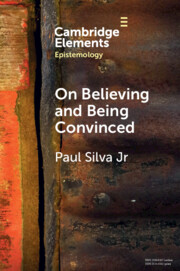Refine search
Actions for selected content:
72 results
13 - Response Confidence
-
- Book:
- Diffusion Process Models of Decision Making
- Published online:
- 26 October 2025
- Print publication:
- 13 November 2025, pp 402-430
-
- Chapter
- Export citation
4 - What is the relationship between oracy edcuation and confidence for students and teachers?
- from Part I - Debating Oracy in the UK
-
-
- Book:
- Oracy
- Published online:
- 23 September 2025
- Print publication:
- 31 July 2025, pp 46-65
-
- Chapter
- Export citation
Competence and confidence of health care professionals in using clozapine: a qualitative systematic review and thematic synthesis
-
- Journal:
- Acta Neuropsychiatrica / Volume 37 / 2025
- Published online by Cambridge University Press:
- 30 June 2025, e73
-
- Article
-
- You have access
- Open access
- HTML
- Export citation
Chapter 2 - How do I prepare to be a teacher?
- from Part 1 - Introduction to education
-
-
- Book:
- Introduction to Education
- Published online:
- 14 June 2025
- Print publication:
- 02 June 2025, pp 27-56
-
- Chapter
- Export citation
The strength of weak leaders: an experiment on social influence and social learning in teams
-
- Journal:
- Experimental Economics / Volume 23 / Issue 2 / June 2020
- Published online by Cambridge University Press:
- 14 March 2025, pp. 259-293
-
- Article
- Export citation

On Believing and Being Convinced
-
- Published online:
- 30 January 2025
- Print publication:
- 30 January 2025
-
- Element
- Export citation
3 - Knowing the Least About What Matters Most
- from Part I - Science
-
- Book:
- Five Times Faster
- Published online:
- 24 October 2024
- Print publication:
- 07 November 2024, pp 18-30
-
- Chapter
- Export citation
On the factors influencing confidence in models and simulations for decision-making: a survey
-
- Journal:
- Design Science / Volume 10 / 2024
- Published online by Cambridge University Press:
- 16 September 2024, e15
-
- Article
-
- You have access
- Open access
- HTML
- Export citation
Changes in self-confidence in professional, personal, and scientific skills by gender during physician-scientist training at the University of Pittsburgh
-
- Journal:
- Journal of Clinical and Translational Science / Volume 8 / Issue 1 / 2024
- Published online by Cambridge University Press:
- 05 June 2024, e106
-
- Article
-
- You have access
- Open access
- HTML
- Export citation
8 - Police Decisions Involved in Collecting Eyewitness Identification Evidence
- from Part II - Pretrial Phase Decision-Making
-
-
- Book:
- The Cambridge Handbook of Psychology and Legal Decision-Making
- Published online:
- 22 February 2024
- Print publication:
- 29 February 2024, pp 117-128
-
- Chapter
- Export citation
6 - Move 6: Stay Curious and Adjust
-
- Book:
- Sorting It Out
- Published online:
- 18 January 2024
- Print publication:
- 29 February 2024, pp 179-200
-
- Chapter
- Export citation
10 - Summary and Conclusions
- from Part II
-
- Book:
- Succeeding and Adult Dyslexia
- Published online:
- 11 January 2024
- Print publication:
- 01 February 2024, pp 300-308
-
- Chapter
- Export citation
A normative model for Bayesian combination of subjective probability estimates
-
- Journal:
- Judgment and Decision Making / Volume 18 / 2023
- Published online by Cambridge University Press:
- 24 November 2023, e40
-
- Article
-
- You have access
- Open access
- HTML
- Export citation
‘It's not cricket’: Financial time and postcolonial temporalities in Joseph O'Neill's ‘Netherland’
-
- Journal:
- Finance and Society / Volume 4 / Issue 1 / 2018
- Published online by Cambridge University Press:
- 09 November 2023, pp. 92-107
-
- Article
-
- You have access
- Open access
- Export citation
Chapter 8 - Abstractness and Language as a Social Tool
- from Part II - Abstractness and Language
-
- Book:
- The Freedom of Words
- Published online:
- 20 July 2023
- Print publication:
- 10 August 2023, pp 255-287
-
- Chapter
- Export citation
Differences in metacognitive functioning between obsessive–compulsive disorder patients and highly compulsive individuals from the general population
-
- Journal:
- Psychological Medicine / Volume 53 / Issue 16 / December 2023
- Published online by Cambridge University Press:
- 09 August 2023, pp. 7933-7942
-
- Article
-
- You have access
- Open access
- HTML
- Export citation
Self-Validation Theory: Confidence can Increase but also Decrease Performance in Applied Settings
- Part of
-
- Journal:
- The Spanish Journal of Psychology / Volume 26 / 2023
- Published online by Cambridge University Press:
- 20 April 2023, e5
-
- Article
- Export citation
3 - Knowing the Least About What Matters Most
- from Part I - Science
-
- Book:
- Five Times Faster
- Published online:
- 19 March 2023
- Print publication:
- 06 April 2023, pp 17-27
-
- Chapter
- Export citation
Legitimate child protection interventions and the dimension of confidence: A comparative analysis of populations views in six European countries
-
- Journal:
- Journal of Social Policy / Volume 54 / Issue 2 / April 2025
- Published online by Cambridge University Press:
- 27 March 2023, pp. 508-527
- Print publication:
- April 2025
-
- Article
-
- You have access
- Open access
- HTML
- Export citation
4 - Cebes’ Challenge and the Cyclical Argument
-
- Book:
- Plato's <I>Phaedo</I>
- Published online:
- 02 February 2023
- Print publication:
- 09 February 2023, pp 88-99
-
- Chapter
- Export citation
